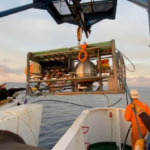
Next step in the deployment of the KM3NeT/ORCA detector
Another KM3NeT/ORCA detector deployment campaign in the Mediterranean was brought to a conclusion in October 2020. A second junction box (JB) has been successfully connected to the KM3NeT/ORCA seafloor network. The JB was deployed to within a metre of its nominal position at a depth of 2450 m.
The JB provides the power to the Detection Units (DUs) and distributes/collects the optical fibres used for the data transmission. The main electro-optic cable (MEOC) provides the input power on a single conductor at 3300 VAC which is transformed in the JB to 400 VAC to power the DUs. The power return is via the sea. The JB provides eight wet-mateable output connectors to which the DUs or Earth and Sea Sciences instrumentation (ESS) are connected via so called interlink cables. Four DUs are daisy chained to a single connector, so a single JB can connect up to 32 DUs. The JB was in fact ready since spring 2020 but due to COVID restrictions its connection was delayed until now.

The final configuration of the KM3NeT/ORCA site: N2 is the new junction box. Cable 2 will be the relocated ANTARES MEOC. MII, BJS, NSVT are earth and sea science instrumentation. Credits: KM3NeT
The campaign took place from the 16 Oct->24 Oct 2020. The operation was quite complex involving the coordination of three ships; i) The Raymond Croze from Orange Marine which managed the deployment of the junction box and the jointing of the main electro optical cables on the input and output of the junction box. ii) The Castor boat from Foselev Marine which managed the output main electro optical cable which, in a future operation, will be connected to a dedicated ESS junction box. iii) The Onyx boat from Foselev Marine which took care of the precision acoustic positioning of the junction box during its installation on the sea floor.
During the sea operation one end of the output MEOC was transferred from the Castor to the Raymond Croze for jointing (first time we have done that) and then the Castor lowered the output cable in synchronisation with the lowering of the JB. All in all, three joints were made; each joint requiring the splicing of up to 36 optical fibres and taking about 24 hours including encapsulation and X-ray control of the joint. We also had a weather standby of 36 hours.
The connection of the new junction box doubles the capacity of the ORCA seafloor network to connect DUs. In order to complete the ORCA sea floor network two more JBs will be needed; these will be connected to the MEOC currently being used by ANTARES telescope, once it is decommissioned and the extremity of the MEOC rerouted to the KM3NeT/ORCA site.
A short drone video of the deployment part of the sea operation can be viewed here.
KM3NeT collaboration
Further information:
- News on the KM3NeT website: Successfull sea operation in times of corona
-
Interview with Paschal Coyle (July 2019): KM3NeT is growing – Recent deployment in the Mediterranean Sea
This project has received funding from the European Union’s Horizon 2020 research and innovation programme under grant agreement No 739560.






